Executive Assessment Mock Test - 10 - GMAT MCQ
30 Questions MCQ Test - Executive Assessment Mock Test - 10
The table below gives 2010 population based on UN estimates and 2050 populations based on UN projections for 19 selected countries. The table also gives the UN estimates of the percentage of the population that is foreign-born for each country in 2010.
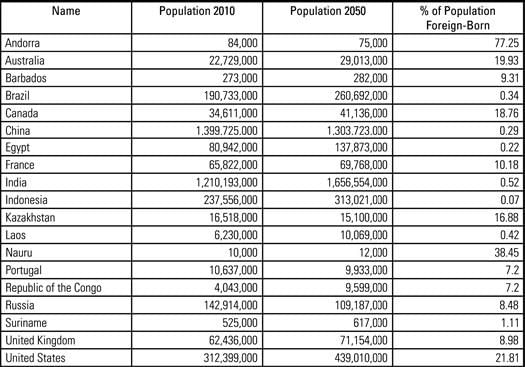
Each column of the table can be sorted in ascending order by clicking on the word “Select” above the table and choosing, from the dropdown menu, the heading of the column on which you want the table to be sorted.
Alternate Sort 1: Population 2010
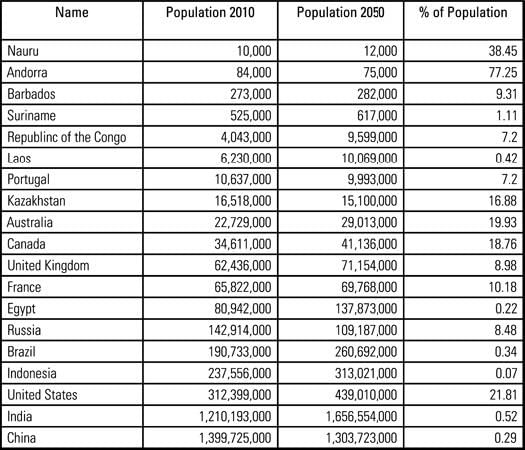
Q. Consider each of the following statements about these countries. For each statement indicate whether the statement is supported based on the information provided in the table.
Of the countries with a population of greater than 150 million in 2010, the one with the median number of foreign-born inhabitants is China.


The table below gives 2010 population based on UN estimates and 2050 populations based on UN projections for 19 selected countries. The table also gives the UN estimates of the percentage of the population that is foreign-born for each country in 2010.
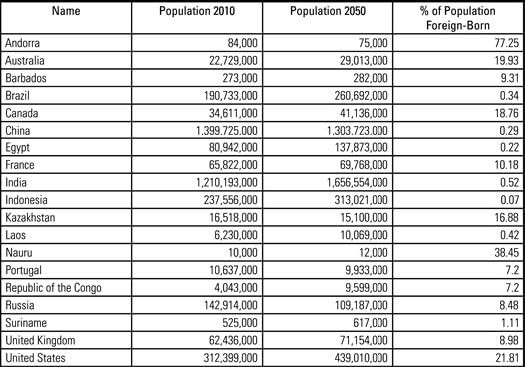
Each column of the table can be sorted in ascending order by clicking on the word “Select” above the table and choosing, from the dropdown menu, the heading of the column on which you want the table to be sorted.
Alternate Sort 1: Population 2010
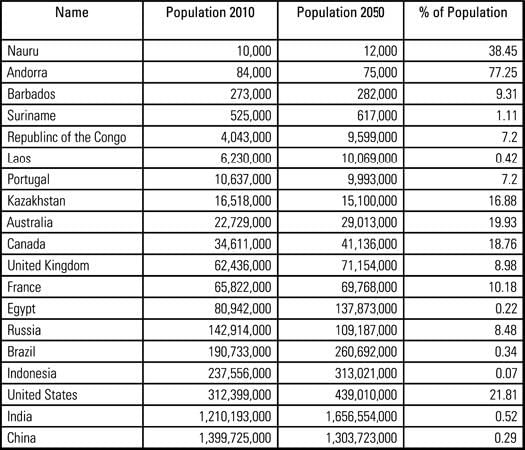
Q. Consider each of the following statements about these countries. For each statement indicate whether the statement is supported based on the information provided in the table.
The total population of Laos is projected to be about 8 million in 2030.


The table below gives 2010 population based on UN estimates and 2050 populations based on UN projections for 19 selected countries. The table also gives the UN estimates of the percentage of the population that is foreign-born for each country in 2010.
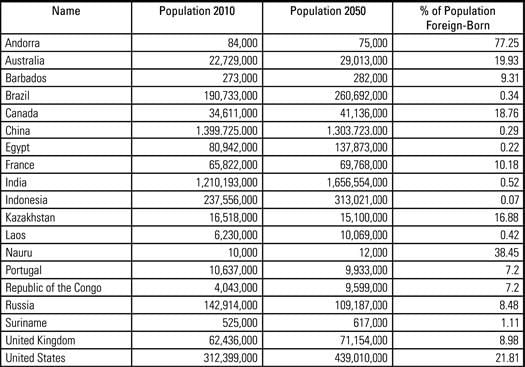
Each column of the table can be sorted in ascending order by clicking on the word “Select” above the table and choosing, from the dropdown menu, the heading of the column on which you want the table to be sorted.
Alternate Sort 1: Population 2010
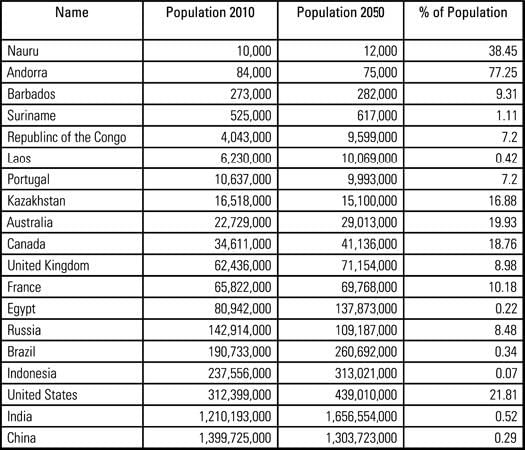
Q. Consider each of the following statements about these countries. For each statement indicate whether the statement is supported based on the information provided in the table.
Andorra has the highest rank in terms of number of foreign-born inhabitants.


The table below gives 2010 population based on UN estimates and 2050 populations based on UN projections for 19 selected countries. The table also gives the UN estimates of the percentage of the population that is foreign-born for each country in 2010.
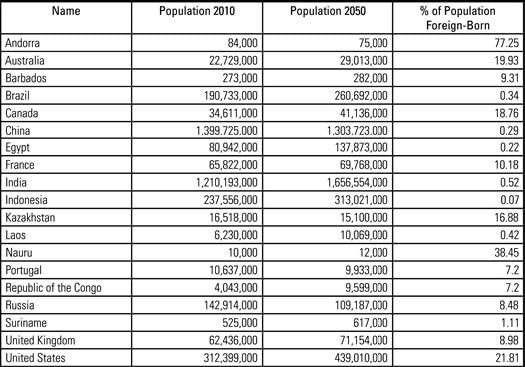
Each column of the table can be sorted in ascending order by clicking on the word “Select” above the table and choosing, from the dropdown menu, the heading of the column on which you want the table to be sorted.
Alternate Sort 1: Population 2010
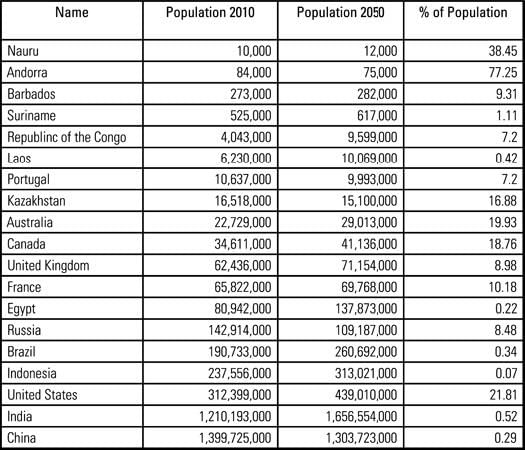
Q. Consider each of the following statements about these countries. For each statement indicate whether the statement is supported based on the information provided in the table.
Russia is projected to have the highest percent decrease in population from 2010 to 2050.
The following emails come from the Public Relations division of a large non-profit organization.

Hello Gloria!
We have to choose a caterer for the upcoming gala. Two under consideration are DoxySource and BrightRight. Although DoxySource has delivered satisfactory service in the past, our First Annual Sponsors Gala promises to be the largest event we have ever hosted, and BrightRight is known for large event planning and production. However, I’d like more information before switching from a tried and true contractor. Also, I’d like to consider how to justify any over-budget costs from using BrightRight, if that comes up. I am committed to using only one provider. Please work up a comparison of costs of services and rentals for BrightRight and DoxySource. We require: tables, audio, food, and a punch fountain or fountains (a dessert fountain would be a lovely addition). Our budget is $6,000.00, and we plan for a maximum of 400 people.
Thanks!
Evelyn Schott
Gala Coordinator

Hello Evelyn,
I’ve broken out the data in the following chart:
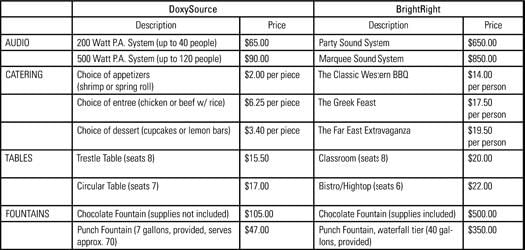
BrightRight offers packages that are generally more elegant and comprehensive, and more expensive. For instance, we can choose a single full meal set, such as “The Greek Feast,” for the entire gala. Using Doxy Source, while more economical and flexible in the catering, does mean more hands-on involvement on our end.
The biggest price difference comes in the audio systems. BrightRight, which consistently hosts events with attendance of several hundreds, offers complex systems that include lights and sound effects, in addition to highdefinition audio reproduction. DoxySource offers two standard, large public address systems. I am not sure whether the Gala will need all the flash and sizzle of the high-end sound system; but the projected attendance is above the recommended usage for DoxySource’s P.A. systems. Due to electrical concerns, we can only have one P.A. system at the gala.
Gloria Welch
Administrative Assistant, Public Relations
Q. Based on the information in the communications above, and assuming the maximum number of guests, which of the following must be true?
If the coordinator uses DoxySource and orders one appetizer, one entrée and one dessert per person, then the table costs will be approximately 16.6% of the food costs.
The following emails come from the Public Relations division of a large non-profit organization.

Hello Gloria!
We have to choose a caterer for the upcoming gala. Two under consideration are DoxySource and BrightRight. Although DoxySource has delivered satisfactory service in the past, our First Annual Sponsors Gala promises to be the largest event we have ever hosted, and BrightRight is known for large event planning and production. However, I’d like more information before switching from a tried and true contractor. Also, I’d like to consider how to justify any over-budget costs from using BrightRight, if that comes up. I am committed to using only one provider. Please work up a comparison of costs of services and rentals for BrightRight and DoxySource. We require: tables, audio, food, and a punch fountain or fountains (a dessert fountain would be a lovely addition). Our budget is $6,000.00, and we plan for a maximum of 400 people.
Thanks!
Evelyn Schott
Gala Coordinator

Hello Evelyn,
I’ve broken out the data in the following chart:
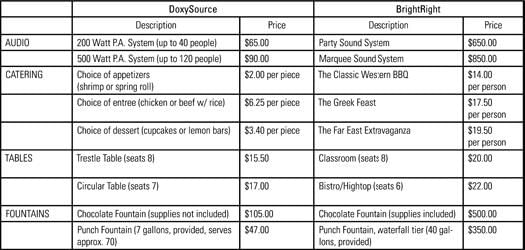
BrightRight offers packages that are generally more elegant and comprehensive, and more expensive. For instance, we can choose a single full meal set, such as “The Greek Feast,” for the entire gala. Using Doxy Source, while more economical and flexible in the catering, does mean more hands-on involvement on our end.
The biggest price difference comes in the audio systems. BrightRight, which consistently hosts events with attendance of several hundreds, offers complex systems that include lights and sound effects, in addition to highdefinition audio reproduction. DoxySource offers two standard, large public address systems. I am not sure whether the Gala will need all the flash and sizzle of the high-end sound system; but the projected attendance is above the recommended usage for DoxySource’s P.A. systems. Due to electrical concerns, we can only have one P.A. system at the gala.
Gloria Welch
Administrative Assistant, Public Relations
Q. Based on the information in the communications above, and assuming the maximum number of guests, which of the following must be true?
If the large punch fountain from BrightRight is sufficient for 400 guests, then using smaller fountains from DoxySource to serve the same number of guests would cost at least 20% less per gallon.
The following emails come from the Public Relations division of a large non-profit organization.

Hello Gloria!
We have to choose a caterer for the upcoming gala. Two under consideration are DoxySource and BrightRight. Although DoxySource has delivered satisfactory service in the past, our First Annual Sponsors Gala promises to be the largest event we have ever hosted, and BrightRight is known for large event planning and production. However, I’d like more information before switching from a tried and true contractor. Also, I’d like to consider how to justify any over-budget costs from using BrightRight, if that comes up. I am committed to using only one provider. Please work up a comparison of costs of services and rentals for BrightRight and DoxySource. We require: tables, audio, food, and a punch fountain or fountains (a dessert fountain would be a lovely addition). Our budget is $6,000.00, and we plan for a maximum of 400 people.
Thanks!
Evelyn Schott
Gala Coordinator

Hello Evelyn,
I’ve broken out the data in the following chart:
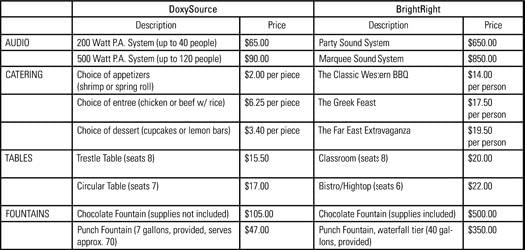
BrightRight offers packages that are generally more elegant and comprehensive, and more expensive. For instance, we can choose a single full meal set, such as “The Greek Feast,” for the entire gala. Using Doxy Source, while more economical and flexible in the catering, does mean more hands-on involvement on our end.
The biggest price difference comes in the audio systems. BrightRight, which consistently hosts events with attendance of several hundreds, offers complex systems that include lights and sound effects, in addition to highdefinition audio reproduction. DoxySource offers two standard, large public address systems. I am not sure whether the Gala will need all the flash and sizzle of the high-end sound system; but the projected attendance is above the recommended usage for DoxySource’s P.A. systems. Due to electrical concerns, we can only have one P.A. system at the gala.
Gloria Welch
Administrative Assistant, Public Relations
Q. Based on the information in the communications above, and assuming the maximum number of guests, which of the following must be true?
If BrightRight is used, the project will go over its present budget by at least 15%.
The following emails come from the Public Relations division of a large non-profit organization.

Hello Gloria!
We have to choose a caterer for the upcoming gala. Two under consideration are DoxySource and BrightRight. Although DoxySource has delivered satisfactory service in the past, our First Annual Sponsors Gala promises to be the largest event we have ever hosted, and BrightRight is known for large event planning and production. However, I’d like more information before switching from a tried and true contractor. Also, I’d like to consider how to justify any over-budget costs from using BrightRight, if that comes up. I am committed to using only one provider. Please work up a comparison of costs of services and rentals for BrightRight and DoxySource. We require: tables, audio, food, and a punch fountain or fountains (a dessert fountain would be a lovely addition). Our budget is $6,000.00, and we plan for a maximum of 400 people.
Thanks!
Evelyn Schott
Gala Coordinator

Hello Evelyn,
I’ve broken out the data in the following chart:
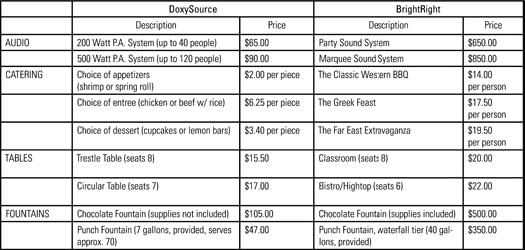
BrightRight offers packages that are generally more elegant and comprehensive, and more expensive. For instance, we can choose a single full meal set, such as “The Greek Feast,” for the entire gala. Using Doxy Source, while more economical and flexible in the catering, does mean more hands-on involvement on our end.
The biggest price difference comes in the audio systems. BrightRight, which consistently hosts events with attendance of several hundreds, offers complex systems that include lights and sound effects, in addition to highdefinition audio reproduction. DoxySource offers two standard, large public address systems. I am not sure whether the Gala will need all the flash and sizzle of the high-end sound system; but the projected attendance is above the recommended usage for DoxySource’s P.A. systems. Due to electrical concerns, we can only have one P.A. system at the gala.
Gloria Welch
Administrative Assistant, Public Relations
Q. Which of the following statements can be most reasonably inferred from the messages between the Gala Coordinator and the Administrative Assistant?
The Gala Coordinator is willing to ask for a budgetary increase, if necessary.
The following emails come from the Public Relations division of a large non-profit organization.

Hello Gloria!
We have to choose a caterer for the upcoming gala. Two under consideration are DoxySource and BrightRight. Although DoxySource has delivered satisfactory service in the past, our First Annual Sponsors Gala promises to be the largest event we have ever hosted, and BrightRight is known for large event planning and production. However, I’d like more information before switching from a tried and true contractor. Also, I’d like to consider how to justify any over-budget costs from using BrightRight, if that comes up. I am committed to using only one provider. Please work up a comparison of costs of services and rentals for BrightRight and DoxySource. We require: tables, audio, food, and a punch fountain or fountains (a dessert fountain would be a lovely addition). Our budget is $6,000.00, and we plan for a maximum of 400 people.
Thanks!
Evelyn Schott
Gala Coordinator

Hello Evelyn,
I’ve broken out the data in the following chart:
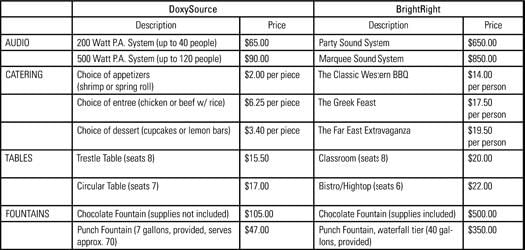
BrightRight offers packages that are generally more elegant and comprehensive, and more expensive. For instance, we can choose a single full meal set, such as “The Greek Feast,” for the entire gala. Using Doxy Source, while more economical and flexible in the catering, does mean more hands-on involvement on our end.
The biggest price difference comes in the audio systems. BrightRight, which consistently hosts events with attendance of several hundreds, offers complex systems that include lights and sound effects, in addition to highdefinition audio reproduction. DoxySource offers two standard, large public address systems. I am not sure whether the Gala will need all the flash and sizzle of the high-end sound system; but the projected attendance is above the recommended usage for DoxySource’s P.A. systems. Due to electrical concerns, we can only have one P.A. system at the gala.
Gloria Welch
Administrative Assistant, Public Relations
Q. Which of the following statements can be most reasonably inferred from the messages between the Gala Coordinator and the Administrative Assistant?
According to the Administrative Assistant, audio costs are not the only determining factor in choosing one event planning service over another.
The following emails come from the Public Relations division of a large non-profit organization.

Hello Gloria!
We have to choose a caterer for the upcoming gala. Two under consideration are DoxySource and BrightRight. Although DoxySource has delivered satisfactory service in the past, our First Annual Sponsors Gala promises to be the largest event we have ever hosted, and BrightRight is known for large event planning and production. However, I’d like more information before switching from a tried and true contractor. Also, I’d like to consider how to justify any over-budget costs from using BrightRight, if that comes up. I am committed to using only one provider. Please work up a comparison of costs of services and rentals for BrightRight and DoxySource. We require: tables, audio, food, and a punch fountain or fountains (a dessert fountain would be a lovely addition). Our budget is $6,000.00, and we plan for a maximum of 400 people.
Thanks!
Evelyn Schott
Gala Coordinator

Hello Evelyn,
I’ve broken out the data in the following chart:
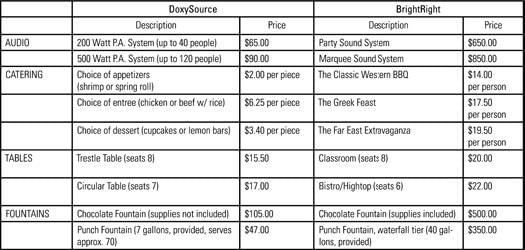
BrightRight offers packages that are generally more elegant and comprehensive, and more expensive. For instance, we can choose a single full meal set, such as “The Greek Feast,” for the entire gala. Using Doxy Source, while more economical and flexible in the catering, does mean more hands-on involvement on our end.
The biggest price difference comes in the audio systems. BrightRight, which consistently hosts events with attendance of several hundreds, offers complex systems that include lights and sound effects, in addition to highdefinition audio reproduction. DoxySource offers two standard, large public address systems. I am not sure whether the Gala will need all the flash and sizzle of the high-end sound system; but the projected attendance is above the recommended usage for DoxySource’s P.A. systems. Due to electrical concerns, we can only have one P.A. system at the gala.
Gloria Welch
Administrative Assistant, Public Relations
Q. Which of the following statements can be most reasonably inferred from the messages between the Gala Coordinator and the Administrative Assistant?
Fountains are an optional element of the gala.
Directions: Read the Passage carefully and answer the question as follow.
Archaeology as a profession faces two major prob-
lems. First, it is the poorest of the poor. Only paltry
sums are available for excavating and even less is avail-
able for publishing the results and preserving the sites
(5) once excavated. Yet archaeologists deal with priceless
objects every day. Second, there is the problem of illegal
excavation, resulting in museum-quality pieces being
sold to the highest bidder.
I would like to make an outrageous suggestion that
(10) would at one stroke provide funds for archaeology and
reduce the amount of illegal digging. I would propose
that scientific archeological expeditions and govern-
mental authorities sell excavated artifacts on the open
market. Such sales would provide substantial funds for
(15) the excavation and preservation of archaeological sites
and the publication of results. At the same time, they
would break the illegal excavator’s grip on the market,
thereby decreasing the inducement to engage in illegal
activities.
(20) You might object that professionals excavate to
acquire knowledge, not money. Moreover, ancient arti-
facts are part of our global cultural heritage, which
should be available for all to appreciate, not sold to the
highest bidder. I agree. Sell nothing that has unique
(25) artistic merit or scientific value. But, you might reply,
everything that comes our of the ground has scientific
value. Here we part company. Theoretically, you may be
correct in claiming that every artifact has potential scien-
tific value. Practically, you are wrong.
(30) I refer to the thousands of pottery vessels and ancient
lamps that are essentially duplicates of one another. In
one small excavation in Cyprus, archaeologists recently
uncovered 2,000 virtually indistinguishable small jugs in
a single courtyard, Even precious royal seal impressions
(35) known as/melekh handles have been found in abun-
dance---more than 4,000 examples so far.
The basements of museums are simply not large
enough to store the artifacts that are likely to be discov-
ered in the future. There is not enough money even to
(40) catalogue the finds; as a result, they cannot be found
again and become as inaccessible as if they had never
been discovered. Indeed, with the help of a computer,
sold artifacts could be more accessible than are the
pieces stored in bulging museum basements. Prior to
(45) sale, each could be photographed and the list of the
purchasers could be maintained on the computer A
purchaser could even be required to agree to return the
piece if it should become needed for scientific purposes.
It would be unrealistic to suggest that illegal digging
(50) would stop if artifacts were sold on the open market.
But the demand for the clandestine product would be
substantially reduced. Who would want an unmarked
pot when another was available whose provenance was
known, and that was dated stratigraphically by the
professional archaeologist who excavated it?
Q. The author mentions the excavation in Cyprus (lines 31-34) to emphasize which of the following points?
Directions: Read the Passage carefully and answer the question as follow.
Archaeology as a profession faces two major prob-
lems. First, it is the poorest of the poor. Only paltry
sums are available for excavating and even less is avail-
able for publishing the results and preserving the sites
(5) once excavated. Yet archaeologists deal with priceless
objects every day. Second, there is the problem of illegal
excavation, resulting in museum-quality pieces being
sold to the highest bidder.
I would like to make an outrageous suggestion that
(10) would at one stroke provide funds for archaeology and
reduce the amount of illegal digging. I would propose
that scientific archeological expeditions and govern-
mental authorities sell excavated artifacts on the open
market. Such sales would provide substantial funds for
(15) the excavation and preservation of archaeological sites
and the publication of results. At the same time, they
would break the illegal excavator’s grip on the market,
thereby decreasing the inducement to engage in illegal
activities.
(20) You might object that professionals excavate to
acquire knowledge, not money. Moreover, ancient arti-
facts are part of our global cultural heritage, which
should be available for all to appreciate, not sold to the
highest bidder. I agree. Sell nothing that has unique
(25) artistic merit or scientific value. But, you might reply,
everything that comes our of the ground has scientific
value. Here we part company. Theoretically, you may be
correct in claiming that every artifact has potential scien-
tific value. Practically, you are wrong.
(30) I refer to the thousands of pottery vessels and ancient
lamps that are essentially duplicates of one another. In
one small excavation in Cyprus, archaeologists recently
uncovered 2,000 virtually indistinguishable small jugs in
a single courtyard, Even precious royal seal impressions
(35) known as/melekh handles have been found in abun-
dance---more than 4,000 examples so far.
The basements of museums are simply not large
enough to store the artifacts that are likely to be discov-
ered in the future. There is not enough money even to
(40) catalogue the finds; as a result, they cannot be found
again and become as inaccessible as if they had never
been discovered. Indeed, with the help of a computer,
sold artifacts could be more accessible than are the
pieces stored in bulging museum basements. Prior to
(45) sale, each could be photographed and the list of the
purchasers could be maintained on the computer A
purchaser could even be required to agree to return the
piece if it should become needed for scientific purposes.
It would be unrealistic to suggest that illegal digging
(50) would stop if artifacts were sold on the open market.
But the demand for the clandestine product would be
substantially reduced. Who would want an unmarked
pot when another was available whose provenance was
known, and that was dated stratigraphically by the
professional archaeologist who excavated it?
Q. The author implies that all of the following statements about duplicate artifacts are true EXCEPT:
Directions: Read the Passage carefully and answer the question as follow.
Archaeology as a profession faces two major prob-
lems. First, it is the poorest of the poor. Only paltry
sums are available for excavating and even less is avail-
able for publishing the results and preserving the sites
(5) once excavated. Yet archaeologists deal with priceless
objects every day. Second, there is the problem of illegal
excavation, resulting in museum-quality pieces being
sold to the highest bidder.
I would like to make an outrageous suggestion that
(10) would at one stroke provide funds for archaeology and
reduce the amount of illegal digging. I would propose
that scientific archeological expeditions and govern-
mental authorities sell excavated artifacts on the open
market. Such sales would provide substantial funds for
(15) the excavation and preservation of archaeological sites
and the publication of results. At the same time, they
would break the illegal excavator’s grip on the market,
thereby decreasing the inducement to engage in illegal
activities.
(20) You might object that professionals excavate to
acquire knowledge, not money. Moreover, ancient arti-
facts are part of our global cultural heritage, which
should be available for all to appreciate, not sold to the
highest bidder. I agree. Sell nothing that has unique
(25) artistic merit or scientific value. But, you might reply,
everything that comes our of the ground has scientific
value. Here we part company. Theoretically, you may be
correct in claiming that every artifact has potential scien-
tific value. Practically, you are wrong.
(30) I refer to the thousands of pottery vessels and ancient
lamps that are essentially duplicates of one another. In
one small excavation in Cyprus, archaeologists recently
uncovered 2,000 virtually indistinguishable small jugs in
a single courtyard, Even precious royal seal impressions
(35) known as/melekh handles have been found in abun-
dance---more than 4,000 examples so far.
The basements of museums are simply not large
enough to store the artifacts that are likely to be discov-
ered in the future. There is not enough money even to
(40) catalogue the finds; as a result, they cannot be found
again and become as inaccessible as if they had never
been discovered. Indeed, with the help of a computer,
sold artifacts could be more accessible than are the
pieces stored in bulging museum basements. Prior to
(45) sale, each could be photographed and the list of the
purchasers could be maintained on the computer A
purchaser could even be required to agree to return the
piece if it should become needed for scientific purposes.
It would be unrealistic to suggest that illegal digging
(50) would stop if artifacts were sold on the open market.
But the demand for the clandestine product would be
substantially reduced. Who would want an unmarked
pot when another was available whose provenance was
known, and that was dated stratigraphically by the
professional archaeologist who excavated it?
Q. The primary purpose of the passage is to propose
(a) an alternative to museum display of artifacts
(b) a way to curb illegal digging while benefiting the archaeological profession
(c) a way to distinguish artifacts with scientific value from those that have no such value
(d) the governmental regulation of archaeological sites
(e) a new system for cataloguing duplicate artifacts
In countries where healthcare is universal and provided free of charge by the government, visits per capita to the doctor are twice as frequent as they are in countries where healthcare is paid at least partly out-of-pocket by the consumer. Presently, governments do not have a reliable way of determining whether the symptoms for which these patients were treated for would have otherwise subsided without medical attention. However, this information does not warrant the conclusion by some universal healthcare critics that in the countries with a higher frequency of doctor visits, about half of them are unnecessary. Alternatively, in those countries where healthcare is not free, consumers often forego visits to the doctor except in cases of severe symptoms.
Q. In the argument above, the two underline portions play which of the following roles?
Business School Dean: We are all in agreement that we must cut unnecessary costs in order to afford our popular international study programs, a hallmark of our unique offering that prospective students know us for. But cutting the marketing budget would be a terrible idea; after all, our unique international programs cannot attract prospective students if we do not properly market them.
Q. The portions highlighted in underlined play which of the following roles?
Recently, motorists have begun purchasing more and more fuel-efficient economy and hybrid cars that consume fewer gallons of gasoline per mile traveled. With that trend, there has been debate as to whether we can conclude that these purchases will actually lead to an overall reduction in the total consumption of gasoline across all motorists. The answer is no, since motorists with more fuel-efficient vehicles are likely to drive more total miles than they did before switching to a more fuel-efficient car, negating the gains from higher fuel-efficiency.
Q. Which of the following best describes the roles of the portions in underline?

The dark purple region on the number line above is shown in its entirety. This region is delineated by which of the following inequalities?
The profits of QRS company rose 10% from March to April, then dropped 20% from April to May, then rose 50% from May to June. What was the percent increase for the whole quarter, from March to June?
There are two sets of letters, and you are going to pick exactly one letter from each set.
Set #1 = {A, B, C, D, E}
Set #2 = {K, L, M, N, O, P}
What is the probability of picking a C or an M?
How many four-digit positive integers exist that contain the block 25 and are divisible by 75. (2250 and 2025 are two such numbers)?
A car drives for 3 hours at 40 mph and then drives 300 miles at 60 mph. What is the car’s average speed, in mph?

If |x| < 20 and |x – 8| > |x + 4|, which of the following expresses the allowable range for x?
In a certain game, you pick a card from a standard deck of 52 cards. If the card is a heart, you win. If the card is not a heart, the person replaces the card to the deck, reshuffles, and draws again. The person keeps repeating that process until he picks a heart, and the point is to measure: how many draws did it take before the person picked a heart and won? What is the probability that one will have at least three draws before one picks a heart?
Bert and Rebecca were looking at the price of a condominium. The price of the condominium was 80% more than Bert had in savings, and separately, the same price was also 20% more than Rebecca had in savings. What is the ratio of what Bert has in savings to what Rebecca has in savings.
There are two sets of letters, and you are going to pick exactly one letter from each set.
Set #1 = {A, B, C, D, E}
Set #2 = {K, L, M, N, O, P}
There are these two sets of letters, and you are going to pick exactly one letter from each set. What is the probability of picking at least one vowel?
Susan invited 13 of her friends for her birthday party and created return gift hampers comprising one each of $3, $4, and $5 gift certificates. One of her friends did not turn up and Susan decided to rework her gift hampers such that each of the 12 friends who turned up got $13 worth gift certificates. How many gift hampers did not contain $5 gift certificates in the new configuration?
A candy store sells 50 types of candies, each type costing one dollar per candy. No customer is sold more than one candy. The store accepts only one-dollar bills or green tokens issued by the store. Each token costs two dollars. If a customer buys one candy with a token, a one-dollar bill is returned to the customer as change. Every day, at the start of the day, the store keeps exactly 300 one-dollar bills and no green tokens in its cash register.
On a particular day, 600 candies were sold. On that day, customers were twice as likely to have paid with one-dollar bills as with green tokens.
In the table, select the number of one-dollar bills and the number of green tokens present in the cash register at the end. Make only two selections, one in each column.
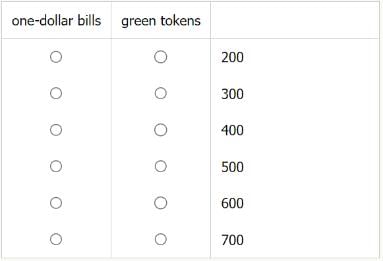
The graph shows the per share price of the stock of three companies at the end of each year between 2002 and 2011.
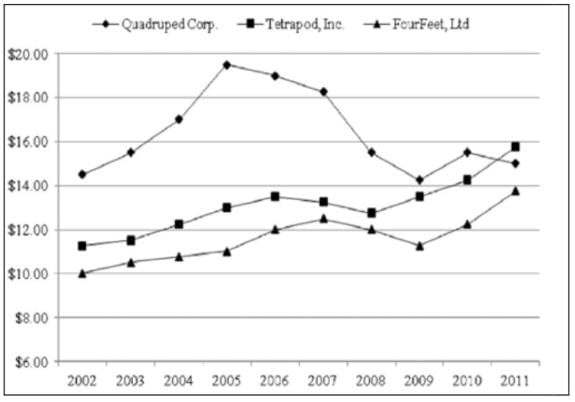
Based on the given information, fill in the blanks in each of the following statements.
1. Between the end of 2003 and the end of 2007, the stock of ____ experienced the greatest percent appreciation.
2. At the end of 2005, the per share price of Tetrapod, Inc. was approximately ____ times the sum of the per share prices of Quadruped Corp. and FourFeet, Ltd.
A small library has books on twenty different subjects, with history being the most prominent. A librarian picks 100 books for reshelving from those returned that day, all of which were borrowed over the past three weeks. Are fewer than 20% of these 100 books on history?
Statement 1: Fewer than 20 per cent of the books in the library are on history.
Statement 2: During the past three weeks, exactly 15 books on history were borrowed from the library.
Window 1: News Article in Major Newspaper
If current trends continue, 24 million men will find themselves bachelors for life by 2020. China’s “one-child policy” has had an unintended effect: the narrowing of the gene pool. Female children are aborted more than 50 percent of the time, because families want a male heir. From 2000 to 2013, the sex-ratio at birth has gradually climbed to 117:100 in favor of male births, meaning that for every 117 boys only 100 girls were born.
Window 2: Interview with Genetic Expert
The one-child policy, first put into effect in the 1980s, was designed to slow the rapid growth of the Chinese people, as that growth was causing severe overcrowding. Leaders believed the policy would protect the country’s resources and improve productivity. Unfortunately, they did not foresee that the long-held preference for male heirs would lead to a substantial gender imbalance.
Since the introduction of the policy, the fertility rate among Chinese women has dropped from just over 3 births per woman to just 1.8. It is estimated that even though the country has reduced births by roughly 50 percent, there are still 1 million more children born each week than people dying, creating a steady increase in population in spite of the law.
Window 3: Commentary on the social side effects
The gender imbalance resulting from China’s one-child policy has produced noticeable side effects. The more severe this imbalance becomes, the more severe its social side effects will be.
The imbalance causes men who know they are unlikely to form strong family ties to become vagrants. The nation has experienced an increased crime rate that is frequently linked to a large transient population of about 80 million unmarried, low-status, adult males. These individuals are commonly willing to resort to crime to improve their situations, given they have no family ties and perceive that they have nothing to lose.
Q. Consider each of the items listed below. Select Yes if the item can be determined based on the information given in the three sources. Otherwise, select No.
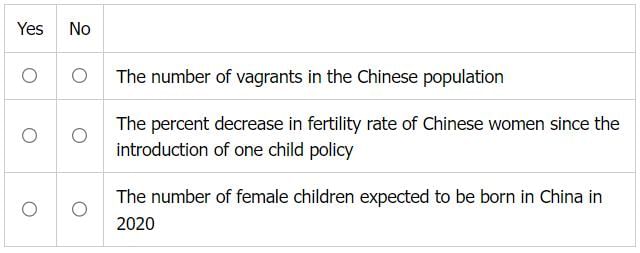



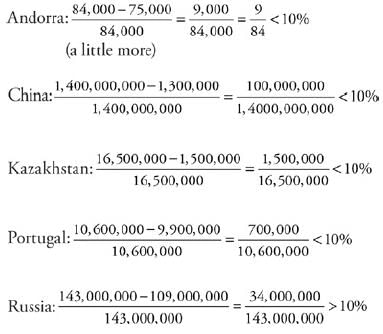
 which is approximately 23%.
which is approximately 23%.











